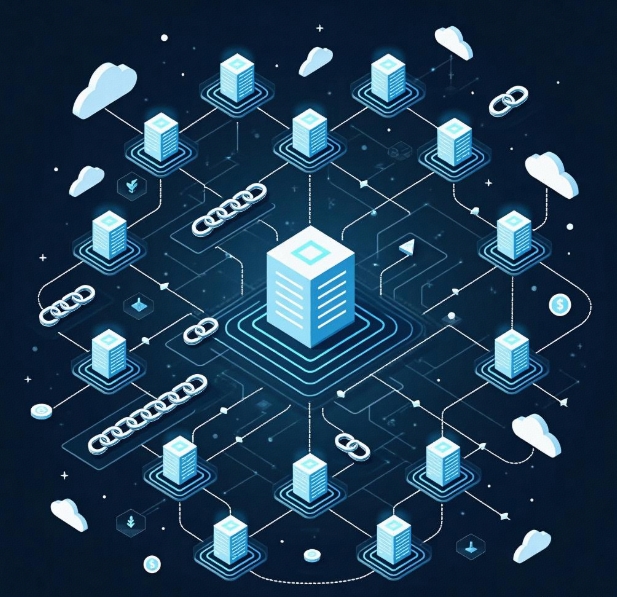The Application and Development Prospects of Blockchain in Copyright Protection
- latest articles
- 1.DApp Development & Customization: Merging Diverse Market Needs with User Experience 2.Analysis of the Core Technical System in DApp Project Development 3.How to achieve cross-chain interoperability in Web3 projects? 4.How does the tokenization of points reconstruct the e-commerce ecosystem? 5.How to Set and Track Data Metrics for a Points Mall? 6.What is DApp Development? Core Concepts and Technical Analysis 7.Inventory of commonly used Web3 development tools and usage tips 8.Development of a Distribution System Integrated with Social E-commerce 9.Six Key Steps for Businesses to Build a Points Mall System 10.What is DApp Development? A Comprehensive Guide from Concept to Implementation
- Popular Articles
- 1.Future Trends and Technology Predictions for APP Development in 2025 2.Analysis of the DeFi Ecosystem: How Developers Can Participate in Decentralized Finance Innovation 3.From Zero to One: How PI Mall Revolutionizes the Traditional E-commerce Model 4.DAPP Development | Best Practices for Professional Customization and Rapid Launch 5.Recommended by the Web3 developer community: the most noteworthy forums and resources 6.From Cloud Computing to Computing Power Leasing: Building a Flexible and Scalable Computing Resource Platform 7.How to Develop a Successful Douyin Mini Program: Technical Architecture and Best Practices 8.Shared Bike System APP: The Convenient Choice in the Era of Smart Travel 9.How to Create a Successful Dating App: From Needs Analysis to User Experience Design 10.From Design to Development: The Complete Process of Bringing an APP Idea to Life
With the rapid development of digital technology, content creators are facing increasingly severe copyright protection issues. From traditional paper publishing to today's digital content, the management and protection of copyright have become a focal point of discussion worldwide. However, traditional copyright management mechanisms still have many drawbacks, especially in the digital environment, where issues such as piracy, infringement, and data tampering continue to occur. Blockchain technology, as a decentralized, tamper-proof distributed ledger technology, is gradually being introduced into the field of copyright protection and demonstrates great potential. This article will explore the application of blockchain in copyright protection and its future development prospects.
I. Overview of Blockchain Technology
Blockchain technology was first proposed by Bitcoin and is a decentralized distributed ledger technology. Blockchain maintains a shared database through multiple nodes in the network, with each data block (block) linked to the previous one through cryptographic means, forming a "chain." Each block contains transaction records, timestamps, and encrypted hash information, ensuring that once data is written into the blockchain, it cannot be altered or deleted, guaranteeing the immutability and transparency of the data.
Due to its characteristics of decentralization, data immutability, and transparency, blockchain has been applied in various industries such as finance, supply chain, and healthcare. In recent years, the application of blockchain technology in the field of digital copyright protection has attracted widespread attention and has gradually become a new technological solution to address copyright management issues.

II. Applications of Blockchain in Copyright Protection
Transparency and Immutability of Copyright Information
Traditional copyright management systems rely on centralized management institutions, such as copyright associations and publishing houses. While these institutions play an important role in copyright management, they also face issues such as lack of transparency and susceptibility to data tampering. The decentralized nature of blockchain ensures the openness and transparency of all copyright information, and once recorded on the blockchain, the information cannot be altered or deleted, effectively preventing tampering with copyright information.
For example, blockchain can record the creation time, author information, and copyright ownership of each creative work, allowing all relevant parties to query this information at any time, ensuring clear and transparent copyright ownership. Additionally, the decentralized nature of blockchain enables the management of copyright information without relying on any single central institution, reducing management costs and risks.
Application of Smart Contracts in Copyright Transactions
Smart contracts are self-executing contracts that automatically perform predefined operations when specific conditions are met. In copyright protection, smart contracts can be used to automate copyright transactions and licensing. For example, creators can use smart contracts to license their works to third parties. When the third party pays the corresponding fee, the smart contract automatically executes the copyright licensing process, ensuring the fairness and transparency of the transaction.
The application of smart contracts can greatly simplify the copyright transaction process, reduce the involvement of intermediaries, and lower the cost of copyright transactions. At the same time, since all transaction processes are recorded on the blockchain, no party can tamper with the transaction information, ensuring the security and reliability of the transactions.
Copyright Tracing and Anti-Piracy Prevention
The application of blockchain technology in copyright tracing is also one of its important features. Through blockchain, every authorization, transfer, and transaction of a work can be fully recorded on the blockchain. These records can not only trace back to the original author of the work but also to every transaction of the work, helping copyright holders promptly detect piracy.
In practical applications, copyright holders can use blockchain to track the usage of their works and check for unauthorized copying and distribution. Once piracy is detected, copyright holders can use the evidence in the blockchain records to protect their rights through legal means.
Decentralized Copyright Management Platforms
Blockchain can be used to build decentralized copyright management platforms, allowing content creators and users to transact directly, eliminating the intermediary fees of traditional copyright management platforms. For example, some blockchain-based music copyright platforms enable music creators to directly transact with listeners or music companies, with the platform serving only as the infrastructure for recording and transactions.
The advantage of decentralized copyright management platforms is that they allow creators to better control their works without relying on traditional copyright management institutions. Creators can transact directly with consumers while ensuring the transparency and security of the transaction process.
III. Challenges of Blockchain in Copyright Protection
Although blockchain technology has great potential in the field of copyright protection, it still faces some challenges in practical applications.
Technical Barriers
Blockchain technology is still in the development stage and faces certain technical barriers. For example, the current processing speed of blockchain is relatively slow and cannot quickly handle large amounts of copyright transaction information. Additionally, the scalability of blockchain networks is a problem that needs to be solved. If the number of transactions and data storage on the blockchain becomes too large, it may cause network congestion and affect system efficiency.
Legal and Regulatory Issues
Although blockchain technology solves some problems in copyright protection at the technical level, it still faces many challenges in terms of law and regulation. Due to the decentralized nature of blockchain, traditional copyright legal systems may find it difficult to adapt to this new management model. The legal systems and regulatory policies of different countries vary, which means that the application of blockchain faces different legal obstacles in different regions.
Market Awareness and Acceptance
Although blockchain technology has received widespread attention in academia and industry, it remains a relatively unfamiliar technology for ordinary consumers and creators. To promote the widespread application of blockchain in copyright protection, it is necessary to increase market awareness and educate users about the advantages and usage of blockchain. Additionally, the popularization of blockchain requires the support of relevant enterprises and platforms to promote the implementation and practical application of the technology.

IV. Development Prospects of Blockchain in Copyright Protection
More Intelligent Copyright Management
With the development of blockchain technology, smart contracts will become more intelligent, enabling more complex copyright management and transaction processes. In the future, blockchain will play an even more important role in copyright protection, helping creators and users better manage and trade copyright content.
Cross-Border Collaboration and Industry Integration
Blockchain technology can facilitate cross-border collaboration and integration among different copyright industries. Copyright holders from various fields can collaborate across industries through blockchain platforms, share copyright resources, and expand the copyright market. This will bring more innovation and opportunities to copyright protection, promoting the upgrading of the entire industry.
Popularization and Global Application
With the continuous popularization of blockchain technology and the improvement of legal systems, the application of blockchain in copyright protection will gradually achieve globalization. Creators, copyright holders, and consumers worldwide can engage in borderless copyright transactions and licensing through blockchain platforms, promoting the development of the global copyright market.
Conclusion
The application prospects of blockchain technology in copyright protection are broad, as it can effectively solve the problems in traditional copyright management and provide more secure, transparent, and efficient copyright protection solutions. However, challenges in technology, law, and the market still exist, requiring joint efforts from all parties in the industry to promote the application and development of blockchain technology in the copyright field. As the technology continues to mature and the industry explores it more deeply, blockchain will undoubtedly play an increasingly important role in copyright protection, driving innovation and transformation in the global copyright market.
-

How to achieve cross-chain interoperability in Web3 projects?
With the continuous development of WEB3 technology, Web3 has gradually become an···
-

Inventory of commonly used Web3 development tools and usage tips
With the continuous development of blockchain technology, Web3 has become a hot ···
-

Web3 development trend prediction: analysis of future technology directions and application scenarios
With the gradual development of blockchain technology, the concept of Web3 has m···

 Blockchain
Blockchain










